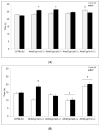Differential Susceptibility to Benzo[a]pyrene Exposure during Gestation and Lactation in Mice with Genetic Variations in the Aryl Hydrocarbon Receptor and Cyp1 Genes
- PMID: 37755789
- PMCID: PMC10537487
- DOI: 10.3390/toxics11090778
Differential Susceptibility to Benzo[a]pyrene Exposure during Gestation and Lactation in Mice with Genetic Variations in the Aryl Hydrocarbon Receptor and Cyp1 Genes
Abstract
Polycyclic aromatic hydrocarbons are ubiquitous air pollutants, with additional widespread exposure in the diet. PAH exposure has been linked to adverse birth outcomes and long-term neurological consequences. To understand genetic differences that could affect susceptibility following developmental exposure to polycyclic aromatic hydrocarbons, we exposed mice with variations in the aryl hydrocarbon receptor and the three CYP1 enzymes from gestational day 10 (G10) to weaning at postnatal day 25 (P25). We found unexpectedly high neonatal lethality in high-affinity AhrbCyp1b1(-/-) knockout mice compared with all other genotypes. Over 60% of BaP-exposed pups died within their first 5 days of life. There was a significant effect of BaP on growth rates in surviving pups, with lower weights observed from P7 to P21. Again, AhrbCyp1b1(-/-) knockout mice were the most susceptible to growth retardation. Independent of treatment, this line of mice also had impaired development of the surface righting reflex. We used high-resolution mass spectrometry to measure BaP and metabolites in tissues from both dams and pups. We found the highest BaP levels in adipose from poor-affinity AhrdCyp1a2(-/-) dams and identified three major BaP metabolites (BaP-7-OH, BaP-9-OH, and BaP-4,5-diol), but our measurements were limited to a single time point. Future work is needed to understand BaP pharmacokinetics in the contexts of gestation and lactation and how differential metabolism leads to adverse developmental outcomes.
Keywords: CYP1A1; CYP1A2; CYP1B1; aryl hydrocarbon receptor; benzo[a]pyrene; neonatal lethality; polycyclic aromatic hydrocarbons.
Conflict of interest statement
The authors have no conflict to declare.
Figures











Similar articles
-
Inhibition of aryl hydrocarbon receptor transactivation and DNA adduct formation by CYP1 isoform-selective metabolic deactivation of benzo[a]pyrene.Toxicol Appl Pharmacol. 2008 Jul 15;230(2):135-43. doi: 10.1016/j.taap.2008.02.009. Epub 2008 Feb 21. Toxicol Appl Pharmacol. 2008. PMID: 18372000
-
The behavioral effects of gestational and lactational benzo[a]pyrene exposure vary by sex and genotype in mice with differences at the Ahr and Cyp1a2 loci.Neurotoxicol Teratol. 2022 Jan-Feb;89:107056. doi: 10.1016/j.ntt.2021.107056. Epub 2021 Dec 7. Neurotoxicol Teratol. 2022. PMID: 34890772 Free PMC article.
-
Aryl Hydrocarbon Receptor-Dependent Metabolism Plays a Significant Role in Estrogen-Like Effects of Polycyclic Aromatic Hydrocarbons on Cell Proliferation.Toxicol Sci. 2018 Oct 1;165(2):447-461. doi: 10.1093/toxsci/kfy153. Toxicol Sci. 2018. PMID: 30137621 Free PMC article.
-
Modulation of benzo[a]pyrene-DNA adduct formation by CYP1 inducer and inhibitor.Genes Environ. 2017 Apr 10;39:14. doi: 10.1186/s41021-017-0076-x. eCollection 2017. Genes Environ. 2017. PMID: 28405246 Free PMC article. Review.
-
Role of aryl hydrocarbon receptor-mediated induction of the CYP1 enzymes in environmental toxicity and cancer.J Biol Chem. 2004 Jun 4;279(23):23847-50. doi: 10.1074/jbc.R400004200. Epub 2004 Mar 17. J Biol Chem. 2004. PMID: 15028720 Review.
References
-
- ATSDR Polycyclic Aromatic Hydrocarbons (PAHs)|ToxFAQsTM|ATSDR. [(accessed on 12 July 2023)]; Available online: https://wwwn.cdc.gov/TSP/ToxFAQs/ToxFAQsDetails.aspx?faqid=121&toxid=25.
-
- ATSDR Substance Priority List|ATSDR. [(accessed on 1 August 2023)]; Available online: https://www.atsdr.cdc.gov/spl/index.html.
-
- Yang L., Zhang H., Zhang X., Xing W., Wang Y., Bai P., Zhang L., Hayakawa K., Toriba A., Tang N. Exposure to Atmospheric Particulate Matter-Bound Polycyclic Aromatic Hydrocarbons and Their Health Effects: A Review. Int. J. Environ. Res. Public Health. 2021;18:2177. doi: 10.3390/ijerph18042177. - DOI - PMC - PubMed
-
- EPA Climate Change Indicators: Wildfires. [(accessed on 13 July 2023)]; Available online: https://www.epa.gov/climate-indicators/climate-change-indicators-wildfires.
Grants and funding
LinkOut - more resources
Full Text Sources
Molecular Biology Databases

